Global Change in Agricultural Flash Drought over the 21st Century※
2024-04-11EmilyBLACK
Emily BLACK
1National Centre for Atmospheric Science,Fairbairn House,71-75 Clarendon Road,Leeds,LS2 9PH,U.K.
2Department of Meteorology,Brian Hoskins Building,University of Reading,Whiteknights campus,Reading,RG6 6ET,U.K.
ABSTRACT Agricultural flash droughts are high-impact phenomena,characterized by rapid soil moisture dry down.The ensuing dry conditions can persist for weeks to months,with detrimental effects on natural ecosystems and crop cultivation.Increases in the frequency of these rare events in a future warmer climate would have significant societal impact.This study uses an ensemble of 10 Coupled Model Intercomparison Project (CMIP) models to investigate the projected change in agricultural flash drought during the 21st century.Comparison across geographical regions and climatic zones indicates that individual events are preceded by anomalously low relative humidity and precipitation,with long-term trends governed by changes in temperature,relative humidity,and soil moisture.As a result of these processes,the frequency of both upperlevel and root-zone flash drought is projected to more than double in the mid-and high latitudes over the 21st century,with hot spots developing in the temperate regions of Europe,and humid regions of South America,Europe,and southern Africa.
Key words: flash drought,climate change,soil moisture,agricultural drought,CMIP
1.Introduction
Drought occurs when dry conditions persist over an extended period of time.Depending on how dry conditions are defined,drought can be characterized as meteorological(precipitation deficit),agricultural (soil moisture deficit),or hydrological (reduced stream flow).Traditionally,drought has been thought of as a slowly developing phenomenon that persists over one or more seasons [for example,Mishra and Singh (2010)].However,it is now recognized that intense drying that develops rapidly may severely impact agricultural and hydrological systems even if the dry conditions persist only for a few weeks.These abrupt and intense events are termed “flash droughts” (Svoboda et al.,2002).In 2012,for example,flash drought devastated large parts of the United States (Otkin et al.,2016,2018;Basara et al.,2019;Jin et al.,2019).
Flash droughts are characterized by rapid transition from normal to dry conditions.This sudden dry-down is driven by a combination of low precipitation and high evaporative demand (Otkin et al.,2013,2014;Koster et al.,2019;Lesinger and Tian,2022;Osman et al.,2022).Flash drought is an extreme phenomenon,with most of the extra-tropics affected less than one year in five.However,in some regions of the tropics,such as India,South America,and the Sahel,flash drought is more common (Christian et al.,2021).In these regions,most events tend to occur outside their main rainy seasons.
The occurrence of flash drought varies on decadal,interannual,and seasonal timescales.Historical trends vary geographically,with small increases in the northern high latitudes,and mixed signals in the tropics (Christian et al.,2021).Formal attribution studies have detected anthropogenic intensification of flash droughts in Southern Africa(Yuan et al.,2018) and China (Yuan et al.,2019;Wang and Yuan,2021).Comparison with meteorological extreme indices also suggests an anthropogenic influence on flash drought risk in Europe (Shah et al.,2022).
The detection of anthropogenic trends in historical flash drought incidence raises the question of future change.A comprehensive study of meteorologically defined events found that frequency,duration and intensity are projected to increase globally over the 21st century under a range of scenarios (Sreeparvathy and Srinivas,2022).Regionally,trends in flash drought may be driven by changes in statistics of the weather.For example,greater intraseasonal variability in Indian precipitation is projected to lead to more frequent events during the June-September monsoon season (Mishra et al.,2021).
There is no single definition of a flash drought (Lisonbee et al.,2021),and comparisons highlight the sensitivity of variability and trends to the choice of metric (Osman et al.,2021).Meteorologically based indices use a combination of heatwave and precipitation metrics as proxies for precipitation deficit and high evaporation (e.g.,Christian et al.,2021;Sreeparvathy and Srinivas,2022).Other studies have used soil moisture-based metrics (Yuan et al.,2019;Mukherjee and Mishra,2021;Otkin et al.,2021),vegetation indicators (Christian et al.,2022),and evaporation indicators(Nguyen et al.,2019).Defining flash drought in a future climate creates additional challenges.Assumptions about the present-day relationship between potential evapotranspiration (PET) and soil moisture,based on present-day land-atmosphere interactions may not be valid under climate change[Berg and Sheffield (2018)].To overcome this issue,some published studies have used soil moisture-based definitions of flash drought (Yuan et al.,2019).Furthermore,recent work has suggested divergent trends in upper-level and fullcolumn soil moisture (Berg et al.,2017),raising the question of how trends in root-zone and surface events may differ.
This paper aims to quantify the projected global change in agricultural flash drought events over the 21st century and to determine how the drivers of change vary on continental scales.It builds on a recent study of global change in meteorological flash droughts (Sreeparvathy and Srinivas,2022)and a number of regional studies (e.g.Yuan et al.,2019),through a global multi-model analysis of future projections of upper and mid-depth soil moisture flash droughts.The global variation in drivers of variability and change is investigated through comparison of drought projections in geographically and climatically defined zones.
2.Data and methodology
2.1.CMIP6 models,time slices,and scenarios
This study is based on output from an ensemble of 10 CMIP6 (Coupled Model Intercomparison Project 6) models[see Eyring et al.(2016) for an overview of CMIP6].A single ensemble member is used for each model (where available:r1i1f1).Two scenarios,SSP2-4.5 and SSP5-8.5,are compared.SSP2-4.5 is a middle-of-the-road pathway,with a stabilization in emissions projected around the middle of the 21st century;SSP5-8.5 is a fossil-fuel development pathway,with emissions stabilizing at the end of the 21st century[O’Neill et al.(2016)].Data were extracted for 1850-2100,and the following time slices were analyzed: 1960-1990 (historical),2030-2060 (medium term),and 2060-2090 (long term).The reason for using 30-year rather than 20-year time slices is to account for decadal variations in slowly varying fields,such as deep soil moisture.Historical model integrations (CMIP Historical) are spliced together with projections from 2015 onwards (ScenarioMIP SSP2-4.5 and SSP5-8.5).All changes are expressed relative to the 1960-1990 period.
The models were chosen based on the availability of daily data for historical and future periods for the following variables (standard CMIP6 variable name given in brackets):
• Soil moisture at multiple levels (mrsol)
• Surface relative humidity (hurs)
• Precipitation (pr)
• 2-m air temperature (tas)
It should be noted that at the time that the analysis was carried out,only 12 out of~40 CMIP6 models had daily multi-level soil moisture data for the historical period and both the SSP2-4.5 and SSP5-8.5 scenarios.In the two cases where more than one resolution of a model was available,the lower-resolution version was chosen.
Table 1 provides basic details about the models used in this study.

Table 1.CMIP6 models used in this study
The model data were processed as follows.
• Daily data were extracted from the BADC or DKRZ ESGF gateways (http://esgf-index1.ceda.ac.uk or http://esgfdata.dkrz.de)
• The model output was re-gridded to a common 144 ×96 grid using bi-linear interpolation,and a common landsea mask was applied (all analyses are carried out for land points only)
• In the case of soil moisture,two variables were extracted: soil moisture in the top layer of soil and soil moisture aggregated over the top~1 m of soil.A depth of 1 m was chosen because it is representative of the rooting zone for annual crops during the majority of crop development phases,including the critical flowering period (Steduto et al.,2009).
• The daily,re-gridded data were aggregated to 5-day(pentad) means
2.2.Climatic classifications and study areas
Climatic classifications are based on the Köppen-Geiger system [(Köppen (1936),Geiger (1961)].For this study,updated maps of present-day Köppen-Geiger zones were re-gridded to the common model grid given above(Beck et al.,2018;data downloaded from http://www.gloh2o.org/koppen/).
The Köppen-Geiger system classifies climate into 5 classes and 30 sub-types.For the purposes of this study,only the first four Köppen-Geiger classes were used,the sub-types were not considered,and polar climate classifications were excluded.The classifications are summarized in Table 2.To compare drought development across geographic and climate zones,we defined the large regions shown in Fig.1.For example,the region A1,(see Fig.1a),encompasses all grid points within the rectangle shown in Fig.1,that fall into the Köppen-Geiger class A.Any points in the rectangle that are not Köppen-Geiger class A are masked out.
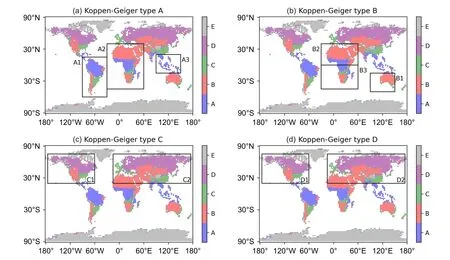
Fig.1.Köppen-Geiger classifications and geographical study regions: (a) Köppen-Geiger type A;(b) Köppen-Geiger type B;(c) Köppen-Geiger type C;(d) Köppen-Geiger type D.

Table 2.Köppen-Geiger classes.Tcold=the air temperature of the coldest month;Thot=the air temperature of the warmest month;Pthreshold=2×mean annual temperature+28 if 70% of precipitation falls in summer,otherwise Pthreshold=2×mean annual temperature +14.The information in this table was extracted from Table 2 in Beck et al.(2018).
2.3.Identification of flash droughts
Flash droughts are identified using soil moisture criteria.The methodology is detailed in Yuan et al.(2019) [see Fig.1 in Yuan et al.(2019)],and summarized below.
• In the three pentads preceding the flash drought (the dry-down period),the mean decline in soil moisture must be>5 percentile points/pentad
• In the pentad preceding the dry-down period,soil moisture must be at or above the 40th percentile
• Following the dry-down period,soil moisture must remain at or below the 20th percentile for an extended period of time.This study considers droughts lasting >3 pentads,>6 pentads,and >9 pentads
• A drought is defined to have started when soil moisture falls below the 20th percentile and ends when soil moisture increases above the 20th percentile
• Soil moisture quantile thresholds vary from pentad to pentad and for every model grid point.This means,for example,that the threshold for the 20th percentile will be different in summer than in winter.Quantiles are derived empirically and based on the entire 1960-2100 period
In this study,flash droughts are defined both for the upper layer of soil and for the top~1 m of soil.
2.4.Comparison between CMIP6 models and ERA5
The multi-model mean CMIP6 historical upper-level and root-zone flash drought climatologies were compared against equivalent climatologies derived from the ERA5 reanalysis (Hersbach et al.,2020).The ERA5 soil moisture is output by the land-surface model,HTESSEL,and driven by the reanalysis of meteorological data.Although,in essence ERA5 soil moisture is a land-surface model product,the daily variability and hence the frequency of droughts is strongly influenced by observed weather conditions.The results of the comparison are presented in the Electronic Supplementary Material (ESM,Figs.S1 -S3).Broadly speaking,the spatial pattern in CMIP6 drought occurrence is similar to ERA5 but the droughts tend to be slightly more frequent in ERA5 than in the CMIP6 data (especially over South America).
2.5.Analysis of pre-cursors to flash droughts
Part of this study analyzes precursors to flash droughts for each of the regions shown in Fig.1.To this end,temperature,precipitation,and relative humidity daily data were aggregated to the pentad scale and converted into quantiles,in an analogous manner to soil moisture (section 2.1).Data were then extracted at each grid point for the three pentads preceding the drought onset (i.e.,the dry-down period),creating a dataset of “dry-down meteorological variables”.
When investigating the drivers of flash drought,independent trends in the meteorological pre-cursors should be accounted for.For example,if a climate change related effect were to lead to more flash droughts in the future,the strong trends in temperature would inevitably lead to an apparent association with positive temperature anomalies,whether or not temperature has any direct effect on flash drought.To account for this,a control dataset was created.Dry-down meteorological variables were paired with the variables for the same pentad and location but for the year after.The metrics shown in the box-and-whisker plots are the differences between the “dry-down” and “control”meteorological quantiles,calculated for each pair of data points.Pairing the data in this way avoids assumptions about the structure of any trends.
3.Results
3.1.Global change in flash drought frequency over the 21st century
By the end of the 21st century,the frequency of flash droughts is projected to increase globally (Fig.2).The increased occurrence is evident under both the SSP2-4.5 and the SSP5-8.5 pathways,with the scenarios diverging from 2060 onwards.Even in the near term (~2000-2020),the multi-model ensemble indicates a significant increase in flash drought frequency,compared to 1960-1990.This is consistent with reports that the risk of flash droughts is already worsening in some regions (Yuan et al.,2018,2019;Wang and Yuan,2021;Shah et al.,2022).The trends are most notable for the longest duration shallow-soil droughts,with the frequency of shallow-soil droughts,lasting >9 pentads projected to double over the course of the 21st century under SSP5-8.5.The uncertainty in the global projections is indicated by the spread in the multi-model ensemble.It can be seen that although there is some variability in the magnitude,the positive trend in drought frequency is robust across the ensemble.
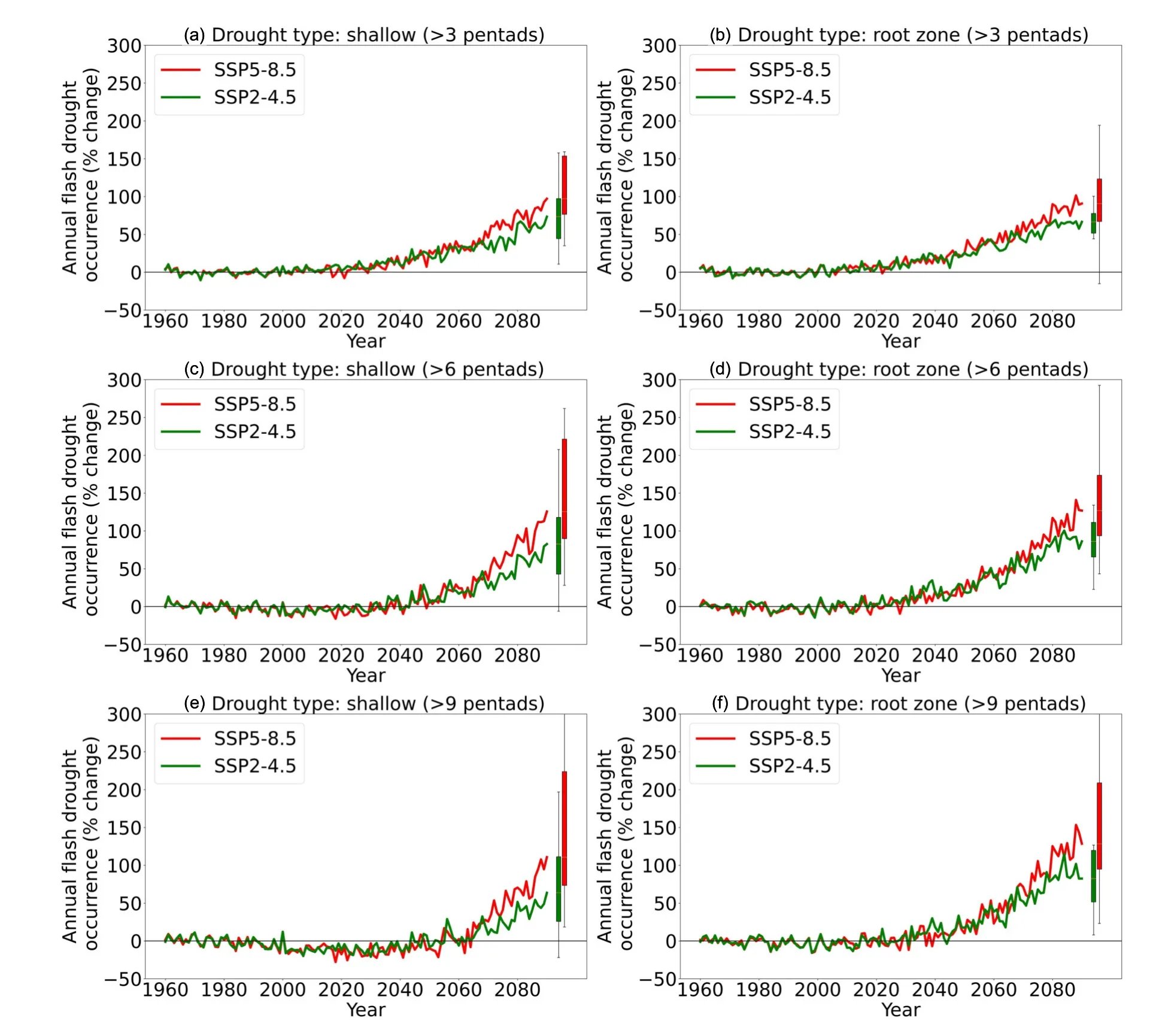
Fig.2.Time series of multi-model mean flash droughts global annual occurrence (expressed as percent change relative to 1960-1990).Left panels (a,c,and e) show flash droughts affecting the upper-most layer of soil;right panels (b,d,and f): flash droughts affecting soil down to a depth of~1 m.Top panels (a,b) show droughts lasting >3 pentads;middle panels (c and d) show droughts lasting >6 pentads;bottom panels (e,f) show droughts lasting >9 pentads.Green lines are SSP2-4.5 and red lines are SSP5-8.5,with the pre-2015 data taken from the historical simulation.The box and whisker plots represent the inter-model spread at 2100 for SSP2-4.5 and SS5-8.5.
The spatial distribution of historical and future shallow and deep soil flash droughts is shown in Figs.3a and 3e for droughts >3 pentads under SSP5-8.5 (see Figs.S4-S9 in the ESM for SSP2-4.5 and for other drought lengths and time slices).In the present day in most areas of the globe,flash droughts are fairly rare events (<1 every five years).Shallow-soil flash droughts are more common than deep-soil flash droughts.“Hot spots” of high drought occurrence are located in the semi-arid regions of Africa and South America.The pattern is somewhat different than the meteorologically defined events,which tend to be concentrated in the most arid regions [Sreeparvathy and Srinivas (2022)].
By the end of the 21st century,flash droughts are projected to become significantly more common throughout the high latitudes,and in most regions of the tropics (Fig.3).The polarity of the projected change in the multi-model mean agrees with the polarity of projected change for most models in the mid-and high latitudes in Eurasia and North America,increasing confidence in the results (Figs.3d,h).However,in the extremely arid tropics,agreement is low,especially for deeper events.Regions of low model agreement tend to coincide with projected changes that are small in comparison to interannual variability.

Fig.3.Multi-model median projected change in flash drought occurrence (expressed as the mean number of droughts per year).From left to right: (a) and (e) present day (1960-1990);(b) and (f) future (2060-2090);(c) and (g) future-present;(d)and (h) the percentage of models that agree on the polarity of the multi-model mean projected change.Hashing on the futurepresent plots indicates that the projected change is insignificant at the 5% level (Welch t-test).The plot is for an SSP5-8.5 scenario;drought length >3 pentads (with the pre-2015 data taken from the historical simulation).The top panels (a-d) are for surface droughts and the bottom panels (e-h) are for root-zone drought.Equivalent figures for other drought lengths and the SSP2-4.5 scenario are included as Figs.S4-S9.
The near-term (2030-2060) time slice and the SSP2-4.5 scenario are shown in Figs S4-S9,together with changes in longer droughts (>6 pentads and >9 pentads).Although the changes are smaller for the shorter time slices and the data are noisier for the longer (and rarer) droughts,these figures show that under both scenarios,in most areas of the globe,significant and robust changes are projected for all drought lengths in the 2030-2060 period,even under the SSP2-4.5 scenario.
Figure 4 compares the projected change in drought occurrence (Figs.4a,b) with projected change in soil moisture(Figs.4c,d),2m air temperature (Fig.4e),precipitation(Fig.4f),and relative humidity (Fig.4g).Soil moisture is projected to decrease in most of the mid-and-high latitudes.Spatial variability in root-zone soil moisture change closely mirrors upper-level change.The projected changes in surface soil moisture in the subset of CMIP6 models considered in this study (Table 1) agree with analyses that encompass a slightly wider group of models [for example,Cook et al.(2020),which analyzed 13 models compared to the 10 considered in this study].The surface soil moisture results also agree with the full CMIP ensemble analyzed in the IPCC report (IPCC,2021,Figure SPM.5).Inconsistencies with the full soil column projections are likely to be related to differences between trends in deep and shallow-soil moisture(Berg et al.,2017),rather than to the included subset of models.

Fig.4.Multi-model mean projected change in (a) shallow drought (events yr-1);(b) root-zone drought (events yr-1);(c) shallow-soil moisture (kg m-2);(d) root-zone soil moisture (kg m-2);(e) 2m air temperature (K);(f)precipitation (mm yr-1);(g) relative humidity (%).Hashing indicates that the projected change is insignificant at the 5% level.The plot is for an SSP5-8.5 scenario,comparing 2060-2090 and 1960-1990 (with the pre-2015 data taken from the historical simulation).Equivalent plots for the SSP2-4.5 scenario and for the 2030-2060 time slice are included in Figs.S10-S13.
To a first order,the polarity in projected changes in drought agrees with the polarity of projected changes in soil moisture.In regions of decreased soil moisture,such as the northern and mid-to high latitudes,and northern South America,an increase in drought occurrence is projected.In the tropics,the alignment is stronger,with the projected reduction in drought occurrence in Africa mapping closely to the increase in soil moisture.In the extra-tropics,the picture is more mixed.In some parts of arid Central Asia,significant increases in soil moisture are associated with increased drought occurrence rather than reduced.The mismatch tends to occur in arid deep continental regions,where the relative humidity is projected to decrease strongly,even as precipitation (and hence soil moisture) increases.In the northern high latitudes,the greatest reductions in soil moisture occur in the east,where warming is greatest,rather than in the more temperate west,where warming is weaker.This is consistent with previous studies that emphasize the importance of surface air temperature as a driver of soil moisture variability in mid-and high latitudes (Gu et al.,2019).
The interplay between regional change in the relative humidity,temperature,and precipitation on climate change timescales is complex,and disentangling these variables is beyond the scope of this study.However,it is worth noting,that divergence between projections of these variables could explain the discrepancy between projections of meteorologically and agriculturally defined flash droughts [cf.Figure 1 of Sreeparvathy and Srinivas (2022) with Fig.3].
3.2.Drivers of regional variation in flash drought change
Change in flash drought frequency is governed by the magnitude and polarity of trends in the underlying environmental drivers.The atmospheric drivers of individual flash drought events might be expected to vary regionally -for example between the humid tropics and the arid high latitudes.However,Fig.5 shows that when the climate change trends in flash droughts and meteorological drivers are accounted for,the precursors for individual flash droughts do not vary significantly between regions or between Köppen-Geiger climate classifications.These results are borne out for individual models (see Figs.S14-S20 in the ESM).In all cases,flash droughts tend to be preceded by low relative humidity (Fig.5c) and low precipitation (Fig.5b).The co-variation between precipitation and relative humidity on short timescales means that low relative humidity and low precipitation are both expected to be pre-cursors of flash drought,regardless of which is the underlying driver.According to Fig.5a,when the climate change trend is removed,air temperature anomalies are not a precursor to flash drought events.This is consistent with the previous discussion (Fig.4e),which showed that while the spatial variation in projected change in air temperature aligns with spatial variation in trends of soil moisture in some regions,on a continental scale,the relationship between projected change in air temperature and flash drought is less pronounced.In particular,the greatest changes in flash drought occurrence are located in temperate regions,rather than in the northern high latitudes,where warming is strongest.

Fig.5.Box and whisker plots of the anomalies for (a) 2m air temperature (top),(b) precipitation (middle),and (c) relative humidity (bottom) in the three pentads preceding deep soil and shallow-soil flash droughts.The box and whisker plots are displayed for the regions shown in Fig.1.
Figure 4 shows that there is considerable spatial variation in both the polarity and magnitude of projected change in precipitation,humidity,and soil moisture.These trends and their relationship to flash drought are explored in more detail in Figs.6-9.
Figure 6 focuses on Köppen-Geiger classification A(humid tropics),and compares three regions: South America(A1),Africa (A2),and South Asia (A3).Increases in precipitation are projected for both the Asian and African regions(A2 and A3),with strong decreases projected in South America (A1) (Fig.6e).Relative humidity is projected to decrease slightly in regions A2 and A3,with a strong decrease projected in A1 (Fig.6f).Consistent with the trends in relative humidity and precipitation,a strong decrease in soil moisture and increase in drought frequency is projected for A1 (Figs.6a-d).For Africa (A2),the strong increase in precipitation is associated with a modest increase in deep soil moisture and a slight reduction in flash drought frequency.For East Asia (A3),in the upper level,soil moisture decreases,and flash drought frequency increases.In the deeper soil,there is little change projected in either soil moisture or drought frequency.The soil moisture change in region A3 does not mirror precipitation change,an unusual characteristic for the tropics,suggesting that small increases in drought frequency are driven by trends in other variables,such as relative humidity.

Fig.6.Time series for drought-relevant metrics for grid points classified as Köppen-Geiger type A for regions A1,A2,and A3 (Fig.1).The time series show multi-model means,derived for historical integrations (1960-2015) combined with the SSP5-8.5 projections (2015-2090) (see Figs S21-S24 in the ESM for SSP2-4.5).All changes and anomalies are derived relative to a 1960-1990 base period.The panels show the following data: (a) percent change in drought frequency for shallow-soil droughts;(b) percent change in drought frequency for deep soil droughts;(c) shallow-soil moisture anomaly;(d)deep soil moisture anomaly;(e) precipitation anomaly;(f) relative humidity anomaly.The box and whisker plots represent the inter-model spread for the year 2100 (colors as on the sub-plot keys).
Similar to Köppen-Geiger climate classification A,the trends in soil moisture and drought for Köppen-Geiger climate classification B (arid tropics: Fig.7),are governed by trends in precipitation and relative humidity.For Australia(B1) and Southern Africa (B3),reductions in precipitation(Fig.7e) and relative humidity (Fig.7f),and consequent reductions in soil moisture are associated with more frequent flash droughts (Figs.7a-c).However,the trends are small and these results should therefore be interpreted with caution.For B2 (Northern Africa),increased precipitation and low change in relative humidity results in wetter soil.However,the trend in flash droughts is weak and inconsistent between models -reflecting their rarity in both present and future climates (Fig.3).
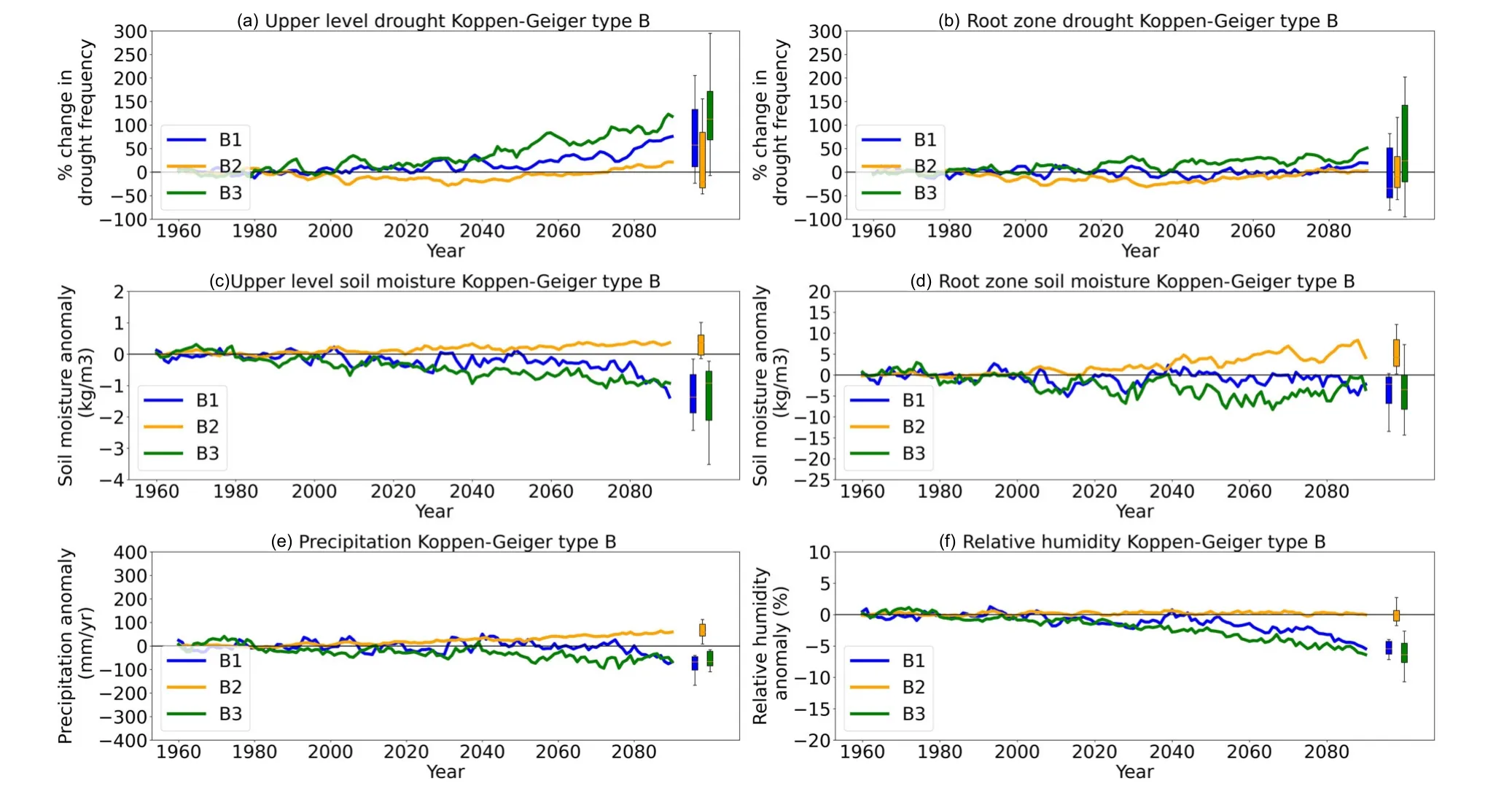
Fig.7.Same as in Fig.6,but for zones B1,B2,and B3.

Fig.8.Same as in Fig.6,but for zones C1 and C2.
Figures 8 and 9 show that spatially averaged precipitation is projected to increase in the temperate and cold northern high latitudes [Köppen-Geiger climate classifications C and D,in North America (C1 and D1) and Eurasia (C2 and D2)]
(Figs.8e and 9e).The trends in precipitation are of similar magnitude for both regions and for both Köppen-Geiger climate classifications.The increased precipitation does not,however,result in increased soil moisture (Figs.8c,d and 9c,d).In fact,a reduction in spatially averaged soil moisture is projected for all four regions.However,the magnitude of the decrease is greater for the cold regions (D1 and D2) than for the temperate regions (C1 and C2).The projected change in drought risk follows the trends in soil moisture,with the greatest increases in frequency projected for regions D1 and D2.
4.Discussion and conclusions
This study aimed to assess how agricultural flash drought will change over the 21st century.At the global scale,the results presented here agree with previous findings,confirming a general worsening of flash drought risk and intensity.However,there are regional differences,especially in the high latitudes,where the links between longterm changes in agricultural and meteorological drought are complex.
Most previous studies have defined flash droughts using meteorological indices [for example,Sreeparvathy and Srinivas (2022)].However,reliance on such indices can exaggerate trends in aridity in some regions and underestimate them in others,due in part to difficulties in characterizing future changes in potential evapotranspiration [Berg and Sheffield (2018),Greve et al.(2019)].To counter this effect,we utilized the direct output of soil moisture by climate models.Droughts in both the uppermost soil layer and deeper(~1 m) soil were considered.Although trends in full-column soil moisture may diverge strongly from trends in the uppermost layer (Berg et al.,2017),in most regions,the trend in the mid-depth (~1 m) soil moisture is similar to that at shallower depths (Fig.4).Consistent with this,the spatial patterns of flash drought trends are similar for shallow and middepth events.However,the trends are consistently weaker for deeper flash droughts,and their occurrence in both present and future periods is lower.
Flash drought development is associated with short timescale anomalies in relative humidity and precipitation.The robustness of the projected changes in flash drought frequency thus depends on the ability of the CMIP6 model ensemble to represent changes in these variables and the subsequent impact on soil moisture.Comparisons between reanalysis and CMIP6 indicate that the CMIP6 models capture the gross spatial and seasonal variability in both deep and shallow-soil moisture for the tropics and the southern mid-andhigh latitudes.Moreover,compared to CMIP5,CMIP6 models show improvements in model skill,especially in the tropics (Dutta and Maity,2022).However,in the northern high latitudes,discrepancies between models and observations remain and are likely related to snow parameterizations in both the reanalysis and CMIP6 models (Qiao et al.,2022).This is consistent with the CMIP3 and CMIP5 ensembles,which show good agreement between model soil moisture projections in most regions apart from the cold northern high latitudes (Dai,2013).The projected changes reported in this study for the cold Köppen-Geiger climate classifications(regions D1 and D2) should therefore be interpreted with caution (Fig.9).
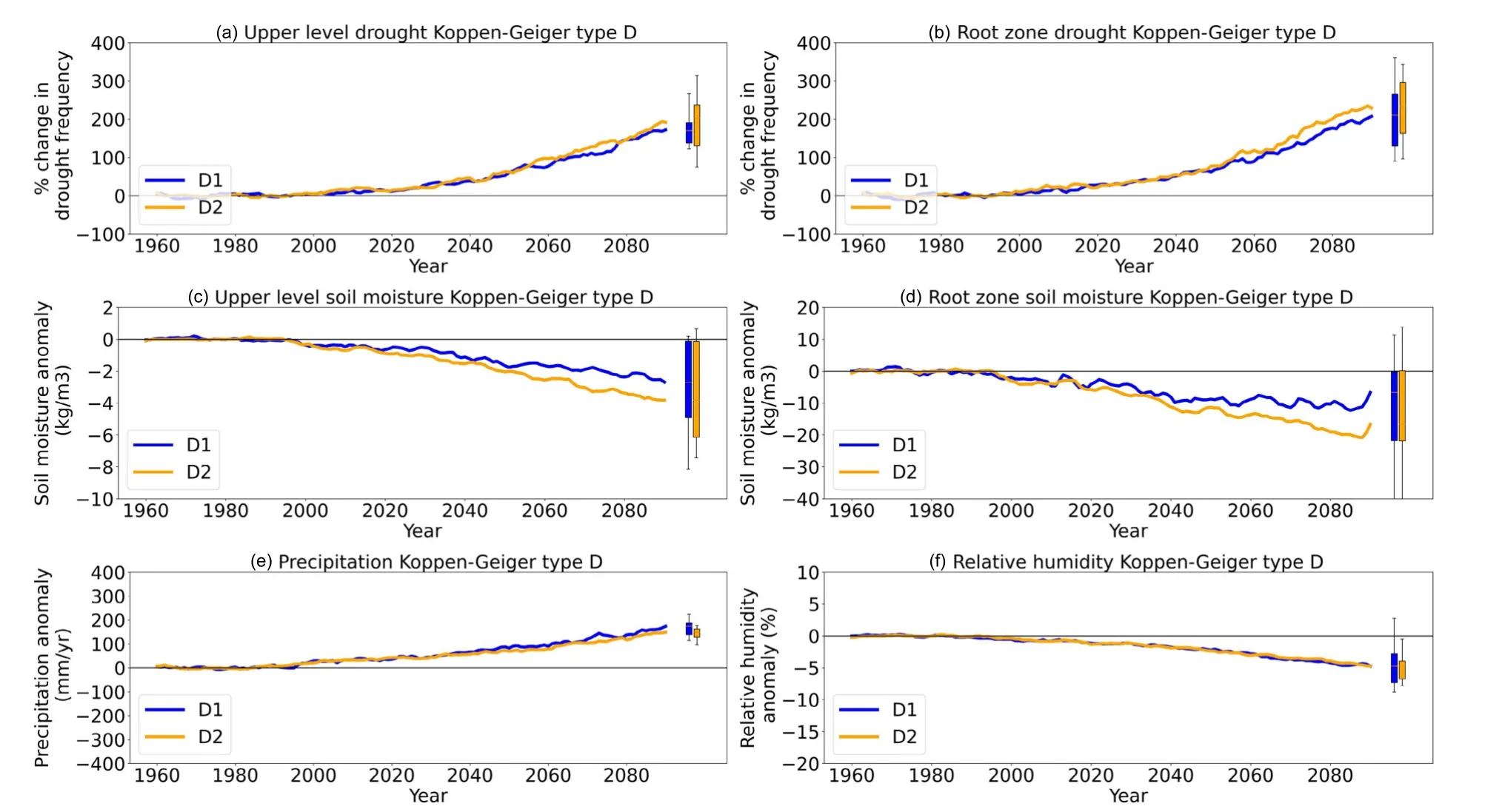
Fig.9.Same as in Fig.6,but for zones D1 and D2.
The role of flash drought in initiating severe seasonal drought is evident in the historical record [for example,Wang and Yuan (2018)].Mid-depth (root zone) flash drought is especially likely to be associated with the development of seasonal agricultural drought.Increased flash drought risk in the future may therefore be associated with a worsening risk of seasonal crop water deficits and subsequent food insecurity.The findings presented here are broadly consistent with previously published global studies of changes in soil moisture/agricultural drought for both the CMIP5 and CMIP6 models.The increased flash drought frequency projected for tropical South America,Central America,Europe,and Southern Africa agree with the hot spots of seasonal agricultural drought risk noted for the CMIP5 ensemble(Lu et al.,2019).
In conclusion,flash droughts are projected to occur more frequently in a future climate,with significant changes projected over the next 30-50 years under both the SSP2-4.5 and SSP5-8.5 pathways.Analysis of Köppen-Geiger climatic classifications indicates that flash droughts are projected to become more frequent throughout the regions classified as temperate or cold,with more mixed signals in the humid and arid zones of the tropics.Hot spots of worsening future flash drought risk are located in tropical South America,North America,and Eurasia.In a future climate,in which flash droughts are more common,their link with longer duration soil moisture deficit may be key to predicting agricultural drought and building resilience to weatherrelated food insecurity.Future work should focus on understanding the interaction between short-duration heat waves,flash drought,and sustained soil moisture deficits.
AcknowledgementsEmily BLACK was supported by the National Centre for Atmospheric Science through the NERC National Capability International Programmes Award (NE/X006263/1),the Global Challenges Research Fund,via Atmospheric hazard in developing Countries: Risk assessment and Early Warning (ACREW) (NE/R000034/1) and the Natural Environmental Research Council and the Department for Foreign International Development through the SatWIN-ALERT project (NE/R014116/1).
Open AccessThis article is licensed under a Creative Commons Attribution 4.0 International License,which permits use,sharing,adaptation,distribution and reproduction in any medium or format,as long as you give appropriate credit to the original author(s) and the source,provide a link to the Creative Commons licence,and indicate if changes were made.The images or other third party material in this article are included in the article’s Creative Commons licence,unless indicated otherwise in a credit line to the material.If material is not included in the article’s Creative Commons licence and your intended use is not permitted by statutory regulation or exceeds the permitted use,you will need to obtain permission directly from the copyright holder.To view a copy of this licence,visit http://creativecommons.org/licenses/by/4.0/.
Electronic supplementary material:Supplementary material is available in the online version of this article at https://doi.org/10.1007/s00376-023-2366-5.
Comparison with ERA5
The following plots compare the CMIP6 multi-model mean historical drought frequency for 1960-1990 against ERA5 for both shallow and root zone droughts.Consistent with the rest of the analysis,droughts lasting >3 pentads,>6 pentads and >9 pentads are considered.Unlike the ERA5 data,which is a single realisation,the CMIP6 data is a multi-model mean.The CMIP6 results are thus generally smoother,especially for the longer droughts.It can be seen that the spatial pattern in CMIP6 drought occurrence is broadly similar to ERA5 but that droughts tend to be slightly more frequent in ERA5 than in the CMIP6 data (especially over South America).It should be noted,however,that -especially for the longest and rarest droughts,it is difficult to draw robust conclusions on occurrence from a 30-year dataset.
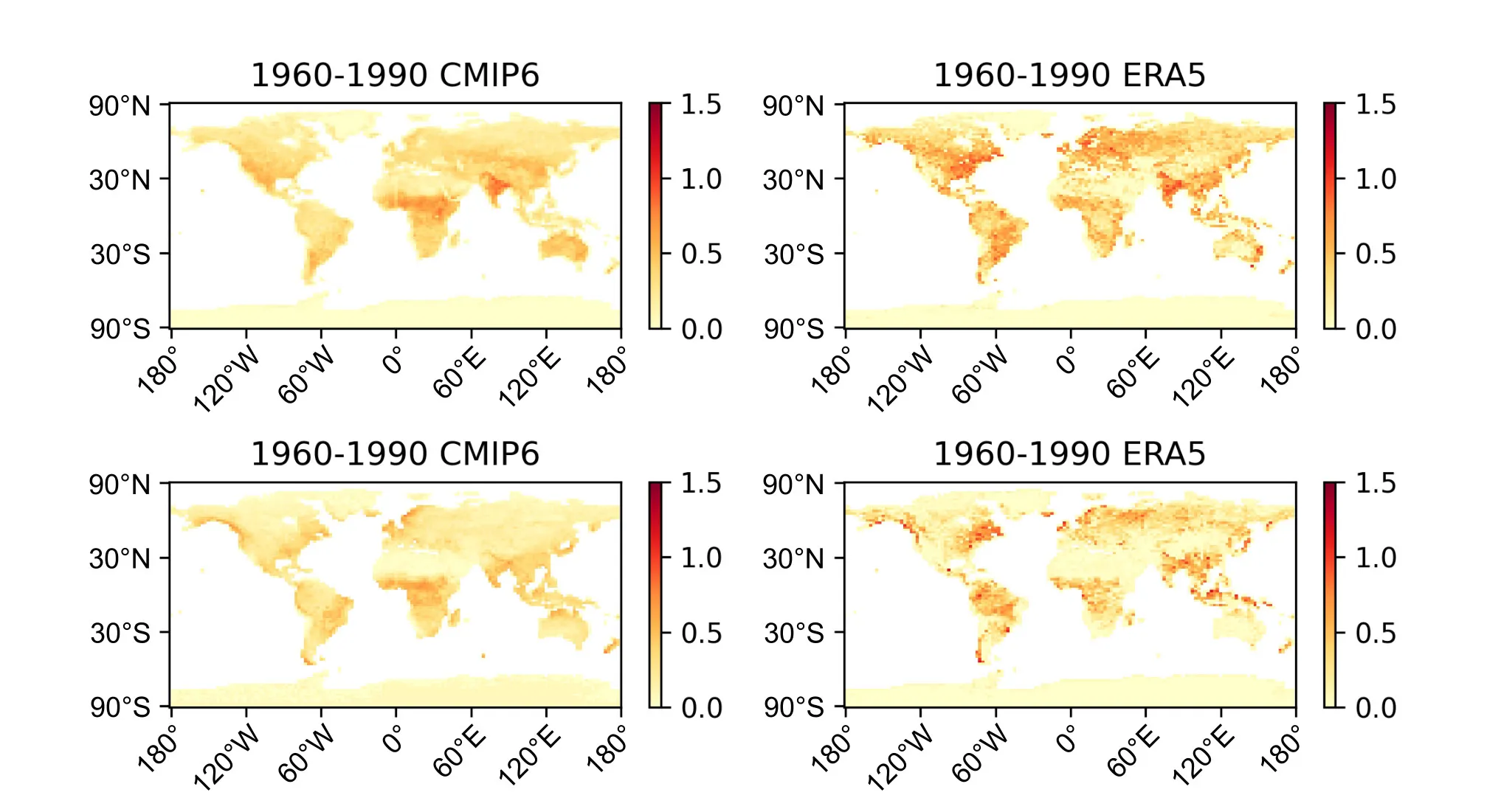
Fig.S1.Droughts lasting >3 pentads (upper panels show upper level soil droughts and lower panels show root zone droughts)

Fig.S2.As for Fig.S1 but for droughts lasting >6 pentads

Fig.S3.As for Fig.S1 but for droughts lasting >9 pentads
Additional maps of multi-model projected changes in drought frequency
The following plots are analogous to Fig.3 in the text for:
• Drought lengths >3 pentads,>7 pentads,>10 pentads
• 2030-2060 and 2060-2090
• SSP245 and SSP585
Scenarios,drought lengths and time slices in the figure titles.Note the changing colour scales.
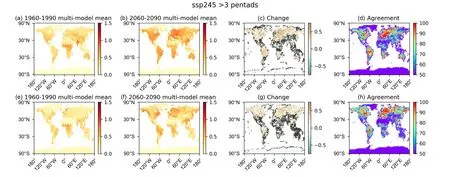
Fig.S4.Multi-model median projected change in flash drought occurrence (expressed as the mean number of droughts per year).From left to right: (a) and (e) present day (1960-1990);(b) and (f) future (2060-2090);(c) and (g) future -present;(d)and (h) the percentage of models that agree on the polarity of the multi-model mean projected change.Hashing on the futurepresent plots indicates that the projected change is insignificant at the 5% level (Welch t-test).The plot is for an SSP2-4.5 scenario;drought length >3 pentads (with the pre-2015 data taken from the historical simulation).The top panels (a-d) are for surface droughts and the bottom panels (e-h) are for root-zone drought.
Additional maps of multi-model projected changes in drought frequency,soil moisture,relative humidity,temperature and precipitation
The following plots are analogous to Fig.4 in the text for:
• 2030-2060 and 2060-2090
• SSP245 and SSP585
Scenarios and time slices in the figure titles.Note the colour scheme change compared to Fig.4.

Fig.S10.Multi-model mean projected change in (a) shallow drought;(b) root-zone drought;(c) shallow-soil moisture;(d) root-zone soil moisture;(e) 2m air temperature;(f) precipitation;(g) relative humidity.Hashing indicates that the projected change is insignificant at the 5% level.The plot is for an SSP2-4.5 scenario,comparing 2030-2060 and 1960-1990 (with the pre-2015 data taken from the historical simulation).
Drought pre-cursors for individual models
As for Fig.5 in the main text,but for individual models
Time series for the Koppen-Geiger regions
Figures 6,7,8 and 9 but for the SSP245 scenario

Fig.S14.Box and whisker plots of the anomalies for (a) 2m air temperature (top),(b) precipitation (middle),and (c)relative humidity (bottom) in the three pentads preceding deep soil and shallow-soil flash droughts.The box and whisker plots are displayed for the regions shown in Fig.1[ACCESS-ESM-1-5]

Fig.S21.As in Fig.6,but for the SSP2-4.5 scenario
杂志排行
Advances in Atmospheric Sciences的其它文章
- Circulation Pattern Controls of Summer Temperature Anomalies in Southern Africa
- Impacts of Ice-Ocean Stress on the Subpolar Southern Ocean:Role of the Ocean Surface Current
- The Spatiotemporal Distribution Characteristics of Cloud Types and Phases in the Arctic Based on CloudSat and CALIPSO Cloud Classification Products
- Attribution of Biases of Interhemispheric Temperature Contrast in CMIP6 Models
- Two-Stream Approximation to the Radiative Transfer Equation:A New Improvement and Comparative Accuracy with Existing Methods
- Impact of Sky Conditions on Net Ecosystem Productivity over a “Floating Blanket” Wetland in Southwest China
